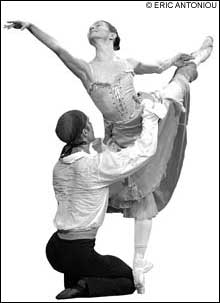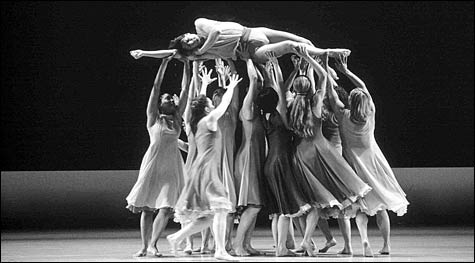
LONDON CALLING: Manon as Romeo and Juliet’s ugly stepsister.
|
This year we were looking forward to dance performances at the Barbara Lee Family Foundation Theater in the new ICA — but the ICA’s opening was postponed from September to December, and the dance performances found other venues or were moved into 2007. Instead, we got visits from two of the world’s best ballet companies, a flock of Swan Lakes, and Mark Morris old and new including a Boston Ballet commission and the first Boston performance of L’Allegro, il Moderato ed il Penseroso since 1994. Here’s 2006 as seen by Marcia B. Siegel, Debra Cash, and myself.
1.
Birds of a feather
That would be the three Swan Lakes we were treated to, one gray and gorgeous from the Kirov Ballet, one graceful and elegant (along with a sleepy Sleeping Beauty) from the Tchaikovsky Perm Ballet, under former Boston Ballet principal Natalia Akhmarova, and one a gay Harlequin Romance, the all-male-swan version from Matthew Bourne. This last, with its parody of the British royal family and its men in fluffy white leggings, was lots of fun, even if there wasn’t much dancing.
2. London calling
The Kirov wasn’t the only high-profile ballet visitor this year — the Bank of America Celebrity Series also brought us the Royal in the Boston premiere of Kenneth MacMillan’s Manon. With its art prostituted to MacMillan’s politics, it perhaps wasn’t the best choice (why not Frederick Ashton?), but we did get three delectable Manons in Tamara Rojo, Alina Cojocaru, and Zenaida Yanowsky, plus former Boston Ballet principal Sarah Lamb — now a Royal principal — as Lescaut’s mistress, though she’d have been even more fetching without MacMillan’s trademark red hooker wig.
3. And the home team . . . ?
The year’s Boston Ballet highlight was an idiomatic-looking performance of Bronislava Nijinska’s Les Noces, part of “An Evening of Russian Dance,” a program that attested more to the richness of Russian tradition than to the virtuosity of Boston dancing. The “Grand Slam” quartet of contemporary work — Helen Pickett’s Etesian, Jorma Elo’s Plan to B, Mark Morris’s Up and Down, Val Caniparoli’s Lambarena — was more down than up, and many were puzzled as to why it got two weeks and Frederick Ashton’s poignant La Fille Mal Gardée only one. Jorma Elo’s Carmen, set to Rodion Shchedrin’s Bizet suite, was an intriguing, if not always lucid, experiment that looked evanescent next to George Balanchine’s Serenade. A company that can get down for Les Noces and up for Serenade would seem to be going in the right direction, and yet the Don Quixote and Nutcracker that finished out the year bespoke a degree of bland and generic that was foreign to Boston Ballet a decade ago, and these days bravura is spelled J-o-e-l P-r-o-u-t-y.
4.
Mark Morris old and new
In January, Mark Morris Dance Group brought one of his defining works, L’Allegro, il Moderato ed il Penseroso, to town for the first time in a dozen years. March saw the world premiere of Morris’s Up and Down, a piece commissioned by Boston Ballet; he had his usual weekend at Jacob’s Pillow, and we caught his Mostly Mozart Festival–commissioned Mozart Dances at Lincoln Center. He can be obvious in the ways he illustrates music; he’s most appealing when his ideas don’t depend wholly on the musical structure.
5.
New York, New York
Not yet 40, Bolshoi Ballet director Alexei Ratmansky is already choreographing for New York City Ballet. His contribution to NYCB’s Diamond Project was called Russian Seasons, and though that might have you envisioning khovorods and trepaks danced in a simulated birch grove by peasants in earth-toned costumes, he combines steps in new ways, gives his charged virtuosity spaces to breathe, and creates a community (it suggested Les Noces) through a constantly modulating stream of dancing. Twyla Tharp’s The Times They Are A-Changin’, on the other hand, misfired. Bob Dylan is no Billy Joel (whose music Tharp turned into Movin’ Out), and Dylanology, imported into the show, makes you ask more of the characters and leaves you less satisfied with the tinsel.

MARK MORRIS OLD: Is L’Allegro about the cosmos? Or is it about us?
|
6. Out of this world
Butoh dance has a look, a base line of physical dislocation, from which intimate essays and spectacular theater can develop. The Japan Society of Boston brought us a taste of the real thing with a single performance of GooSayTen’s To the White, to the Sky at Zero Arrow Theatre. Morita Itto and Takeuchi Mika slipped from one presence to another, shedding their costumes like insect skins, exposing new possibilities underneath. The performance was shattering in its unexpectedness, a trip to chaos and beyond.
7.
Lexington and Concord (and Arlington)
This year’s Tapestry evening at the National Heritage Museum in Lexington was, as always, full of camaraderie and enthusiasm. In Arlington, Rhythm at the Regent was an old-fashioned evening of tap dancing and tap-inflected variety acts. And Summer Stages Dance in Concord brought us John Jasperse’s Prone, Anna Myer’s All at Once, Karole Armitage’s In this dream that dogs me, and “Three Women Solo,” which this year comprised Risa Steinberg, Nora Chipaumire, and Peggy Baker.
8.
Pillow talk
The highlight of the Jacob’s Pillow season might have been the US premiere of young Finnish choreographer Tero Saarinen’s Borrowed Light, which borrowed the Shaker hymn “Simple Gifts” as its quaking heart. The Pillow also brought us Spanish choreographer Nacho Duato’s Compañía Nacional de Danza 2, Suzanne Farrell Ballet, Pacific Northwest Ballet (Val Caniparoli’s Lambarena looking every bit as touristy as it did on Boston Ballet), Karole Armitage, and, as always, Mark Morris.
9.
The jewels in ballet’s crown
Although George Balanchine’s Jewels — an evening-length trio of ballets, Emeralds, Rubies, and Diamonds, that Mr. B made in 1967 — is one of the jewels of 20th-century ballet, it’s never been seen complete here. (Boston Ballet has done Rubies on its own.) But this year we did get a performance by the Paris Opera Ballet that was shown on PBS and released on DVD. These French dancers have the technical chops to do Balanchine, and the musicality besides; it’s too bad the camerawork can’t always expand to match the choreography. The Kirov did Jewels in New York in 2003; how about in Boston on the company’s next visit?
10.
Last but not least
David Parker’s Nut/Cracked at Concord Academy; Noche Flamenca at the Majestic; Larry Keigwin at Zero Arrow; Seán Curran Company at the Dance New Amsterdam complex in New York; Susan Marshall’s Cloudless at Montclair State University; Jody Sperling at Cambridge Multicultural Arts Center; Debra Bluth’s Beauty, Danger, Life (and it all pleased her) at Zero Arrow; Judith Chaffee’s Still Time at Boston University Dance Theater; Anne Teresa de Keersmaeker’s Fase in the Steve Reich at 70 celebration at BAM.